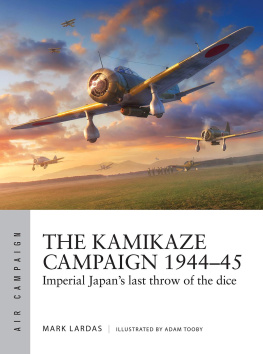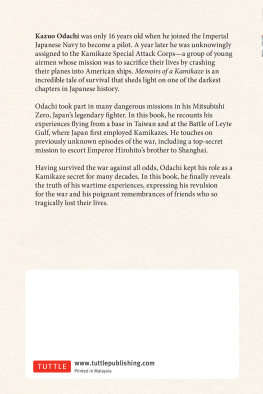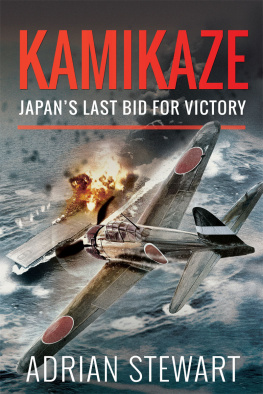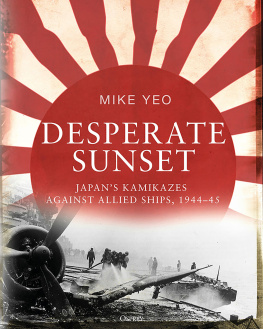BLOSSOMS IN THE WIND: HUMAN LEGACIES OF THE KAMIKAZE
by M.G. Sheftall
To my sons, that they may know a world without war.
Copyright Mordecai G. Sheftall, 2005, renewed 2014
CONTENTS
You and I, blossoms of the same cherry tree
That bloomed at the naval academy.
Blossoms know they must blow in the wind someday
Blossoms in the wind, fallen for th eir country.
- Lyrics from Dki no Sakura, the J apanese naval aviators hymn
A mother, at least with the face she wore in public, was obliged to appear happy and grateful to the emperor and country for giving her son such a fine way to die.
- Hideo Suzuki, former Japanese naval aviator
I t is 1050hrs on October 25, 1944, the fifth day of the American invasion of the Philippines. The scene is the bridge of the escort carrier Fanshaw Bay (CVE-70), Rear Admiral Clifton A.F. Spragues flagship in Task Unit 77.4.3, a force of five small escort carriers, three destroyers and four destroyer escorts now steaming off the coast of Samar Island in the Philippine Sea on a heading of 135 degrees. TU 77.4.3 or Taffy 3 is one of three similarly sized escort carrier forces of the U.S. Seventh Fleet charged with guarding the vulnerable Leyte Gulf invasion fleet anchorage by screening sea approaches to the area. The Taffies are also tasked with supporting the action on land. At present, Taffy 3s five escort carriers are recovering planes from the mornings close air support missions against targets inland of the beachhead.
Not even a year old, the Fannie Bee, as she is affectionately referred to by her crew, is an escort or jeep carrier of the type most other American sailors refer to with dissimilar sentiment as Kaiser Coffins, after the name of their manufacturer and for their alleged tendency to explode, disintegrate into their pre-fabricated sections and sink within minutes when taken under hostile fire. The Fannie Bee is the product of a shipyard in Vancouver, Washington, one of several on the West Coast owned by Henry J. Kaiser, an enterprising industrialist who will go on to short-lived postwar automotive industry notoriety building a series of eccentrically styled, poorly selling cars.
Kaiser is an equal opportunity employer, and the underpaid women and minorities he hires are kicking in and doing their part for Uncle Sam despite the discrimination they suffer outside the shipyard gates, setting spectacular new production records for merchant marine Liberty Ships and U.S. Navy vessels month after month. Kaisers workers are so industrious and hardworking that they have been featured in War Bond advertising. Slapped together deathtraps or not, the jeep carriers they build are playing an enormous role in the war effort.
At the moment, Admiral Sprague is perched in his Air Boss chair on the bridge of the Fanshaw Bay . He is a jowly man, raw-boned and put together a little awkwardly. He does not really look the part of a flag officer. It is much easier to imagine him as the somewhat self-important mayor of an insignificant little Southern town, or a damp-collared, seersuckered Mississippi lawyer with a glib gift of the gab, a penchant for cheap cigars and a passing resemblance to Huey Long. He could even be a Laurel and Hardy foil, destined to end up covered head to toe in house paint or baking flour at some point during the second reel. To look at him, you would never guess that, behind the spare tire and the double chin, he is all guts and backbone.
About three and a half hours ago, from this very chair, the admiral looked through powerful Bausch & Lomb lenses and saw something that would have necessitated an immediate change of underwear in a lesser man. Focusing his binoculars, he could gradually make out something horrible and unthinkable taking shape in the mist, mirage-like in the humidity, distance and heat. Still hull-down in the defilade of the curvature of the earths surface but just poking up over the horizon were the unmistakable giant pagoda-like masts of Japanese battleships barreling straight for Taffy 3 at flank speed. Seconds later, 14- and 18-inch colored dye marker shells bracketed Spragues ships with towering red, yellow, green and purple geysers as the Japanese ranged for their first salvoes. What had started as another workaday morning of routine anti-sub patrols and air support missions had suddenly become a sailors worst nightmare.
Over the next two and a half hours, Sprague directed a touch-and-go running sea battle which cost him one of his carriers, Gambier Bay , and three of his screening destroyers and destroyer escorts, Johnston , Hoel and Samuel B. Roberts . The losses were steep, but now that the smoke has cleared, the dead have been counted and the survivors pulled from the Pacific, it is becoming increasingly clear that with frenzied Wildcat and Avenger sorties, superhumanly courageous fighting by her destroyer screen, and a lot of smoke, bluff and divine providence, Taffy 3 has just fought off the main force of Vice Admiral Takeo Kuritas battleship flotilla and saved the American invasion fleet at Leyte Gulf from certain disaster in one of the most dramatic upsets in naval history.
The Fannie Bee stood down from General Quarters about fifty minutes ago. Crew members are taking cat naps or coffee breaks, trying to talk themselves down from the battle rush. Others smoke Camels and Lucky Strikes and stare off at the flat gray horizon, wondering why they are still alive and if their hands will ever stop shaking. They have just endured two hours of the twentieth century naval equivalent of hand-to-hand combat with fists and club, but they have prevailed, and the Fannie Bee came through like a trouper. She took four 8-inch shells from the cruiser Chikuma but is still making speed. Not too shabby for a Kaiser Coffin.
*****
The year-old CVE-63 a year and two days old, to be exact is another jeep from Kaisers Vancouver yards. Christened Midway in 1943, she was renamed St. Lo just two weeks ago in order to clear her original moniker for a larger carrier. The decision has not sat well with her 889-man crew , for in addition to having to bear the unwelcome onus of a name in honor of some goddamned Army victory, it had to be the absolute worst kind of luck to have your ships name changed right before going into combat like this.
Ever since the shooting started this morning, however, it seems that St. Lo is the luckiest jeep in Taffy 3. She did not suffer as much as a scratch while mixing it up with Kuritas ships, and a sizable number of her crew even had the exceedingly sublime experience of watching one of their own planes, an Avenger piloted by Lieutenant Leonard E. Tex Waldrop, successfully strafe and explode a torpedo from one of Kuritas cruisers that had been heading straight for their sister ship Kalinin Bay . A few seconds after that close call, another of the deadly Long Lance Type 93 Japanese torpedoes missed St. Lo s bow by only a couple of yards.
Radar Technician Third Class Evan Holly Crawforth of McGill, Nevada is on duty in the radar plot room just below St. Lo s flight deck. While he was unable to see LT Waldrops heroics and other events of this mornings fight with the naked eye, his spot in the plot room nevertheless gave him a unique vantage point on the action.
At 0650 this morning, he and the other crewmen in the room were about to secure from their customary early morning General Quarters alert when an unsettling report from one of St. Lo s patrol pilots came in over the radio.
Heads up, the pilot had said. It looks like youve got the whole Jap fleet behind you.
Crawforth immediately looked at his screen and saw that it was filled with flickering green spikes each one representing an enemy warship barreling down hard on Taffy 3. The larger spikes and there were four distinct ones meant battleships, and one of these was so big it could only mean one thing the superbattleship Yamato , which could take out the unarmored St. Lo or any other ship in Taffy 3 with a single round from her main battery of 18-inch guns. Realizing how badly Taffy 3 is outnumbered and outgunned, Crawforth and his mates in the plot room also realized that their own prospects for survival were minimal at best. Just as they were entertaining these happy thoughts, the first deafening Japanese salvo began landing around the St. Lo .
Next page








